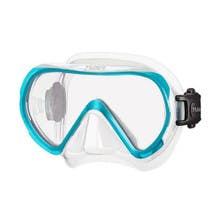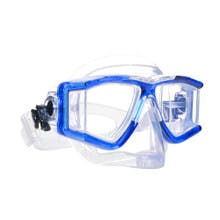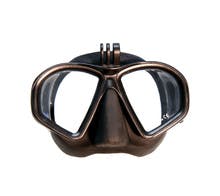Selecting the Perfect Mask

When exploring the underwater world, having the right mask is essential for comfort, visibility, and overall experience. Whether you’re scuba diving, snorkeling, or freediving, choosing the right mask can make all the difference. I know selecting one scuba mask can be overwhelming with the many options to choose from; this guide will help you select the perfect mask based on your activity.
Key Factors to Consider in a Dive Mask
Before diving into specific recommendations, it's important to understand the key factors that make a great dive mask. Fit and comfort are crucial since a proper seal prevents leaks and enhances comfort. A mask should create a snug fit without being too tight. The lens type also plays a role, as single, double, or panoramic lenses affect visibility, and preference varies by activity. Volume is another consideration; low-volume masks are easier to clear and ideal for freediving, while higher-volume masks provide a wider field of view for snorkeling. Additionally, the strap and skirt material matter, with silicone skirts providing better durability and flexibility than rubber ones. Fortunately for our customers, all the scuba masks we offer are made with comfortable, high-quality silicone. But remember, if the scuba mask does not fit right, it will not work right.
Best Masks for Different Activities
Scuba Diving
For scuba diving, a mask should have tempered glass lenses for durability, medium to low volume for easy clearing, and a comfortable skirt for prolonged use. Choosing between dual-lens or single-lens masks is mostly based on consumer preference. A key difference is that dual lens provides less air volume, making clearing water easier. Some masks offer additional features such as prescription lenses, frameless design, and tinted lenses to enhance visibility and comfort underwater.
ScubaMasks
Snorkeling
Snorkeling masks should have a high volume and a wide field of view to provide a comfortable and relaxed experience. Full-face masks are a great option for easy breathing, while traditional scuba masks offer versatility. Additional features such as dry-top snorkels to prevent water entry and anti-fog coatings can improve the overall experience.
SnorkelingMasks
Freediving & Spearfishing
For freediving and spearfishing, low-volume masks are essential as they minimize the amount of air needed for equalization, ensuring a streamlined experience. Frameless or ultra-low volume masks are ideal for reducing drag. Some masks also come with tinted lenses to enhance visibility underwater.
FreedivingMasks
How to Properly Fit & Test a Mask
To ensure a perfect fit, place the mask on your face without using the strap and inhale through your nose. If the mask stays in place without air leaks, it’s a good fit. Adjust the strap correctly—too tight can cause discomfort, while too loose can allow leaks. It’s also important to check for pressure points that might become uncomfortable during extended wear.
Mask Maintenance & Care
Taking care of your mask ensures longevity and optimal performance. Always rinse it thoroughly with fresh water after each use to prevent salt, sand, and chlorine damage. Store it properly in a dry, cool place away from direct sunlight to avoid silicone degradation. Using anti-fog treatments or mild soap can help keep lenses clear during dives.

Choosing the right mask depends on your activity and personal preference. Scuba divers should look for tempered glass and low-volume designs, snorkelers benefit from high-visibility masks, and freedivers need streamlined, low-volume options. Always test for fit before purchasing and maintain your mask to ensure longevity.
Ready to find the perfect mask? Visit your local Divers Direct to try on different styles and see what works best for you!
FAQs
What is a scuba mask called?
A scuba mask, also known as a dive mask, is essential gear for underwater exploration. It creates an air space around your eyes, allowing for clear vision while diving.
Is there a difference between scuba and snorkel masks?
Yes, scuba masks and snorkel masks differ mainly in air volume and pressure resistance. Scuba masks have a lower internal air volume, making it easier for divers to equalize pressure at depth. Snorkel masks often have a higher internal air volume, which is fine for surface use but not recommended for deep diving. Full-face snorkel masks cover the nose and mouth but should never be used for scuba diving due to the inability to equalize pressure.
Is it easier to snorkel or scuba dive?
Snorkeling is easier than scuba diving because it requires less equipment, no certification, and involves floating at the surface. Scuba diving, on the other hand, requires training and specialized gear to manage depth, buoyancy, and breathing underwater.
What color dive mask is best?
The best dive mask color depends on your diving environment and personal preference. Black skirts reduce glare and distractions, ideal for underwater photography. Clear skirts provide a more open, brighter field of view. Brightly colored frames enhance visibility, making it easier for your dive buddy to spot you.
Can you wear glasses under a scuba mask?
No, traditional eyeglasses do not fit under a scuba mask due to the frame interfering with the mask seal. However, divers have several options. We offer prescription dive masks and custom lenses.















